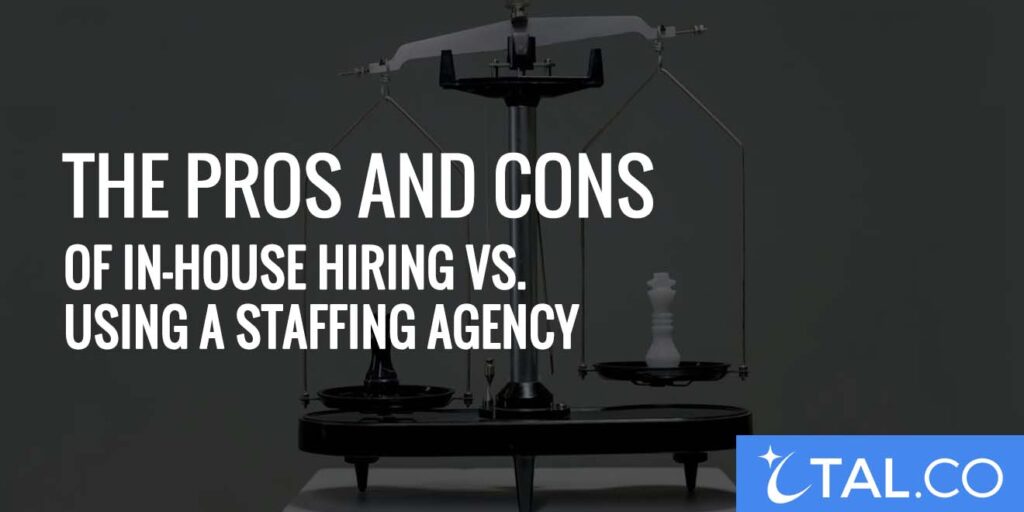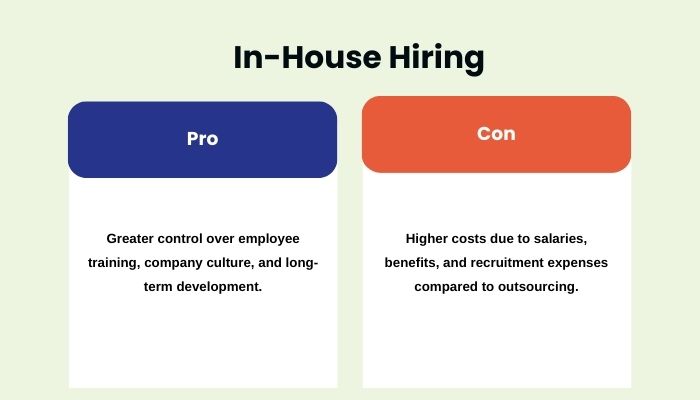
The Pros and Cons of In-House Hiring vs. Using a Staffing Agency
Ah, hiring—the corporate equivalent of an endless game of Jenga. Every decision you make has the potential to either build your dream team or send your entire operation into a downward spiral of regrettable LinkedIn connections. Whether you choose to keep hiring in-house or outsource the madness to a staffing agency, there’s no perfect answer—only a series of trade-offs, some of which are about as pleasant as a surprise audit.
This article isn’t for hiring rookies who just discovered that ATS stands for Applicant Tracking System and not Automated Torture System (though, honestly, it could go either way). We’re diving into the nuances, the hidden costs, and the bureaucratic circus that is talent acquisition, all while keeping things as snarky as your average recruiter’s Twitter feed.
Outline
In-House Hiring: Controlling the Chaos (or Just More Work for HR?)

The Upside: Full Control and Brand Alignment
If you like having absolute control over every aspect of your hiring process, in-house recruitment might sound like a dream. You get to hand-pick every candidate, tailor the interview process, and craft the perfect cultural fit—because nothing screams “company values” like making sure your new hire also prefers LaCroix over Perrier.
With an in-house team, there’s also the advantage of building long-term employer branding. Candidates know who they’re dealing with, and you can ensure that every new hire isn’t just technically qualified but also fully indoctrinated into your company’s mission statement (which, let’s be honest, probably contains the phrase “passionate about innovation”).
But here’s the kicker: the ability to micromanage the hiring process doesn’t mean you should. Companies often fall into the trap of believing that control equals efficiency. In reality, it’s just as likely to create a bureaucratic bottleneck where job postings sit unfilled for months while hiring managers engage in existential debates over whether “dynamic team player” is a better descriptor than “collaborative self-starter.”
The Downside: Slow, Costly, and Bureaucratic Hell
Let’s not sugarcoat it—hiring internally is expensive. By the time you’ve factored in job board postings, recruiting software, and the sheer number of hours spent filtering out candidates who “accidentally” applied for the wrong position, you’re already looking at a significant financial drain.
It also takes forever. Unless you’ve got an army of recruiters working round the clock (spoiler: you don’t), the process of sourcing, screening, and interviewing talent is painfully slow. And the longer it drags on, the more pressure HR faces, often leading to the dreaded panic hire—the corporate equivalent of picking up sushi from a gas station because you were too hungry to wait.
Oh, and bias? It’s real. The more your internal hiring team focuses on “culture fit,” the more likely they are to end up with an office full of people who all went to the same three colleges and have eerily similar Spotify playlists. Diversity of thought? Good luck with that.
Staffing Agencies: The Fast-Track to Talent or Just a Middleman’s Game?
The Perks: Efficiency, Speed, and Less Headaches
The biggest selling point of staffing agencies is their speed. While your in-house hiring team is still fine-tuning the perfect job description, an agency has already found three qualified candidates who can start tomorrow. They have access to a massive talent pool, and their entire existence revolves around filling roles quickly—because, let’s be honest, their profits depend on it.
There’s also the convenience factor. Instead of drowning in a sea of unqualified resumes, you get pre-vetted candidates handed to you on a silver platter. You don’t have to wade through the swamp of “aspiring entrepreneurs” who are really just looking for a paycheck until their NFT project takes off. Agencies do the heavy lifting, and all you have to do is make the final call.
The Pitfalls: The Hidden Costs and Less Control
Of course, there’s a catch—because when is there not? Staffing agencies aren’t doing this out of the goodness of their hearts. They take a cut, and sometimes, it’s a very noticeable one. Contingency fees, retainer models, and markup percentages can all add up quickly, turning what seemed like a cost-effective solution into a financial black hole. And then there’s the issue of control. Since agencies prioritize speed, there’s always the risk of getting the “best available” candidate rather than the “best” candidate.
Sometimes, that distinction matters a lot—especially when you realize your new hire has mastered the art of disappearing after lunch breaks but not much else. If cultural fit is a priority, be prepared for a potential mismatch. Sure, agencies can filter candidates based on skills, but they’re not sitting in your office observing whether everyone is aggressively nodding during Zoom meetings or if the team thrives on passive-aggressive Slack messages.
The Hidden Costs Nobody Talks About
In-House Hiring Costs Beyond Salary
Let’s talk numbers—because, at the end of the day, hiring is just a very expensive game of probability. Keeping hiring internal might seem cost-effective at first, but the associated expenses start stacking up fast. Between job ads, recruiting software subscriptions, training programs, and the sheer amount of time hiring managers spend not doing their actual jobs, the costs get ridiculous.
And if you make a bad hire? Oh, you’re really going to feel it. The cost of a bad hire goes beyond salary—it’s the lost productivity, the training expenses, and the morale hit when everyone has to pick up the slack. Multiply that by a few positions, and suddenly, you’re wondering if outsourcing was the smarter play all along.
Staffing Agency Fees and Markups
But before you go all-in on staffing agencies, let’s not forget their fine print. While they can fill positions quickly, they also come with fees that make airline baggage charges look reasonable.
You’re either paying a flat rate per hire (which can be anywhere from 15% to 30% of the candidate’s first-year salary) or dealing with contract workers who come with ongoing markups. And if the new hire quits in a few months? Well, you better hope your agency offers some kind of replacement guarantee—otherwise, it’s back to square one (and another round of invoices).
When To Choose One Over the Other
Go In-House If…
If you need to build a long-term, sustainable team that understands your company inside and out, in-house hiring is the way to go. It’s best for roles that require deep cultural alignment, specialized training, or a strong leadership pipeline. Just be ready for the slow-moving bureaucracy and the occasional HR-induced migraine.
It’s not enough to match the market anymore; you need to outthink it. Invest in benchmarking data, stay on top of emerging trends, and stop lowballing candidates who can—and will—walk straight into your rival’s open arms.
Use a Staffing Agency If…
If you need talent now, whether for a short-term project or a hard-to-fill specialized role, outsourcing to an agency makes sense. It’s also a great option if you want to test candidates before committing—because let’s be real, hiring someone full-time is basically signing a corporate prenup.
Is There a Right Answer? (No, But Here’s a Good Guess)
There’s no universal right answer—only what works best for your company’s hiring needs. The smartest companies use a hybrid approach, leveraging in-house teams for core hires and agencies for specialized or urgent needs. It’s all about knowing when to take control and when to let someone else handle the chaos.
At the end of the day, hiring is never going to be fun, but at least now you’ll hate it smarter. Because whether you go in-house or outsource, one thing is certain: you’re still going to end up questioning some of your hiring decisions.

